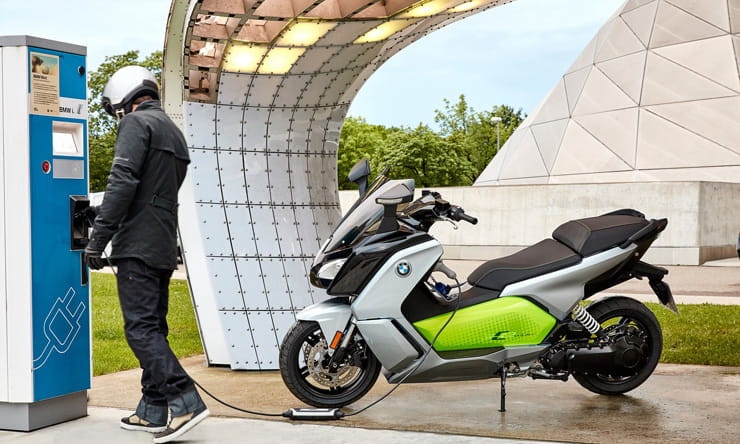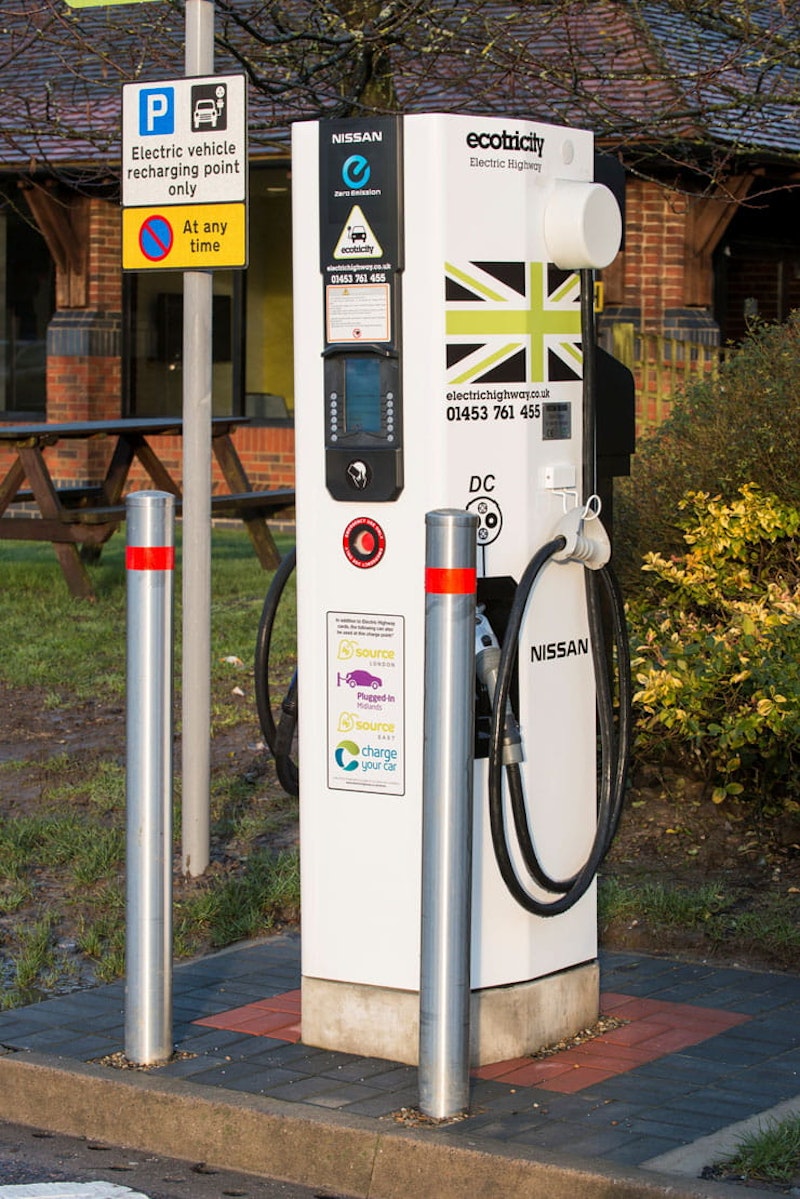You can’t have escaped the front pages screaming of government plans to ban the sale of petrol and diesel cars by 2040 today. But what does it really mean? Digging a little deeper reveals the announcement mightn’t be quite the big news that it’s being made out to be.
At the moment, there’s no word on whether or not motorcycles will be included in the mooted 2040 ban, but it’s safe to assume that two wheelers won’t be given a carte blanche to continue using internal combustion engines long after other road users switch to alternative power. So will we all be forced on to electric bikes as soon as the final syllables of Auld Lang Syne have echoed their last on January 1, 2040?
Of course not.
Is this what petrol pumps will look like circa 2040?
First of all, it’s worth stressing that the proposed ban will be on new vehicles. So even if the 2040 deadline is met – and do these things never happen without deadlines slipping – there’s still the potential for internal combustion engine (ICE) vehicles to be sold right until the end of 2039. Those vehicles may well stay on the roads for another 20 years from that point, so the end of the ICE age is going to be spread out over a far longer period than the shouty headlines suggest.
If bikes are treated as in the past, they’re likely to get a few years’ grace to catch up with their four-wheeled brethren. January 1st this year officially saw the end for the sale of new bikes that meet Euro 3 emissions regulations. Now all should meet Euro 4 – a set of standards that cars have all had to reach since the start of 2006, 11 years earlier – and even then there are still ‘end of life’ loopholes that let Euro 3 models remain available right to the end of 2018. At the moment bikes are due to meet Euro 5 regulations at the start of 2021. Cars had to meet them from 2011. Since September 2015 new cars have had to meet Euro 6 rules; at the moment there’s no timescale in place for bikes to catch up with that. While Brexit means the UK is leaving Europe, there’s little to no chance that we’ll stop adhering to the Euro emissions limits. Many other countries outside Europe also use the Euro emissions standards so manufacturers don’t have to make vehicles that meet multiple standards (the USA being a notable exception.)
So, if the past is an indication of the future, motorcycles could have a decade of leeway beyond the 2040 deadline for the end of ICE.
And that 2040 date itself may prove to be impossibly ambitious. It would be virtually impossible for the government of the day to implement such rules if the infrastructure isn’t in place to support the replacement for them – presumably expected to be electric vehicles. That means there needs to be a nationwide structure, from Land’s End to the Isle of Skye, to fast-charge electric cars. And before you can start building that network, universal standards for such fast-charging need to be agreed and implemented across the motor vehicle industry.
Over and above that, there’s the issue of generating the electricity. Earlier this month the National Grid warned that nine million electric cars – the number expected to be on road by 2030 – could use more power than the new Hinkley Point C nuclear power station will be able to pump out. And nine million is less than a third of the current number of cars on the road. At current growth rates, by 2040 there may well be 45 million cars in use in the UK. If they were all to be replaced with electrics, we’d logically need five power stations the size of Hinkley Point C. That’s a problem. Hinkley Point C was first mooted in 2006 and it won’t be ready until 2023. New power stations don’t get built overnight.
There’s one thing that will accelerate the developing infrastructure, both in terms of the growth of the charging network and the power-generation ability of the country, and that’s commercial demand. And that brings us to the flip side of today’s 2040 deadline; if customers really take to electric vehicles, then the switchover may happen naturally even before we reach that date. Nothing greases the wheels like money and the sniff of a profit.
It’s simple; build electric cars and electric bikes that are better in every way than the vehicles that we can buy right now and people will switch to them. No need for government sabre-rattling and deadlines that are picked purely for being nice, round numbers.
There’s growing impetus behind electric vehicles already. In cars, every major manufacture either already has or is planning a range of electrics, and in bikes we’re starting to see big movement from major players towards electric two-wheelers. Just last week Honda and Yamaha announced a joint pilot project towards the adoption of electric bikes in Japan. Make them, and make them good, and the need to ‘ban’ the sale of ICE-powered vehicles in 2040 will be as irrelevant as a ban on Betamax video cassettes would be today.
The shift away from ICE is already happening, but today’s government announcement isn’t likely to have any effect on how fast it progresses. If the technology struggles, the deadline will simply be missed. If the technology flies, the deadline will be unnecessary. That means the 2040 date really makes no difference other than from to the posturing politicians who have come up with it. And most of them will be dead or retired before it even comes around.
While there are firms that will sell you an electric bike, like Zero, big manufacturers have been slow to adopt the format. That’s changing, though, and there’s a lot of work going on behind the scenes to make sure the technology is ready as soon as there’s enough demand to justify putting it into production.
Japan:
Honda and Yamaha have already come out in support of electric bikes, and have started a joint pilot project in Saitama, Japan, to help develop an infrastructure around them.
Next year Honda will put its EV-Cub scooter into production, and Yamaha already makes the E-Vino electric scooter. Yamaha will also soon launch faster electric bikes including production versions of the PES and PED concepts that have already been shown in two forms in 2013 (PES1 and PED1) and 2015 (PES2 and PED2).
Honda has been less keen to publicly commit to bigger electric bikes, but it’s provided much of the impetus behind the Mugen Shinden electric TT winners over the last few years, and unforgettably showed the stunning RC-E electric superbike in 2011.
Kawasaki and Suzuki have been quieter but both are working on electrics. Kawasaki in particular has filed dozens of electric bike patents, including detailed drawings of an electric Ninja sportsbike (pictured below).
Europe:
KTM and BMW are both already well on-board with electric power. BMW offers the C-Evolution scooter and is developing a second electric scooter model at the moment, while KTM’s Freeride E was a pioneer in the electric bike field. Now KTM has been spied testing an electric Duke and BMW has shown an electrically-powered S1000RR in the form of the unfortunately-named eRR.
America:
The USA is already the home of several electric bike firms, like Zero and Lightning Motorcycles, and Harley-Davidson surprised everyone with its Livewire prototype back in 2014.
Although it’s gone a little quiet since then, the Livewire is still scheduled to spawn an electric production Harley by 2021.
China:
The real hotbed of electric bike development is China, where electric scooters now easily outsell their petrol-powered equivalents. While many are crude, slow devices, with bicycle-style performance from lead-acid batteries, there are also several companies building quite impressive-looking electric motorcycles out there. Machines like the Evoke Urban S – built in China by the company that produces iPhones for Apple – are already starting to appear in export markets, too.
What are your thoughts on the future of the internal combustion engine? Let us know in the comments section below.
Share on social media:

